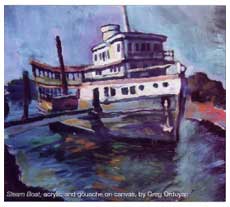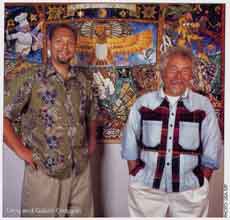 |
 |
explains in his heavy accent.
At the age of six, Galust was told
by his teacher that he would never be an artist. He stormed out of the schoolhouse
and told his mother he was quitting school. "She's stupid. I'm already an
artist," he recalls saying about his teacher.
Despite
his convictions, he returned to school and went on to study journalism, philosophy,
aerospace engineering, and history. "But," he notes with an impish grin,
"I remember nothing of those subjects. What I obtained, however, was a feeling
about each subject and that gave me the ability to create art."
While
the Vietnam War did not directly affect the countries within the Caucasus area,
the hippie movement had grabbed Galust and his friends' attention. He was so impressed
by it that he decided to free his mind and his obligations to his country and
travel the world. He bumped around from country to country within Europe taking
in the art and creating his own before landing in Russia where he met his wife
and began a family.
When their son Greg was two years old,
they realized he, too, was destined to be an artist. With three generations of
well- known artists on Galust's side, this realization came as little surprise.
At the age of seven, Greg began his formal art education at Moscow Art School
where he won a number of awards for his work as a painter.
At age 19, Greg began working as an animator for films that have also received
numerous awards. Despite his flourishing career in Russia, Greg persuaded his
family to come to the United States, which they did by way of New York While Galust
hit the New York art scene, Greg went to work as an artist for a variety of leading
video game companies, including Sony. Later Greg's work took the family to the
video game capital of the world- Silicon Valley.
| |
What happens when a 16-year-old hippie
from the North Caucasus region of Eurasia leaves home to explore the world and
pursue his artistic dreams? In this case, he ended up in Russia, got married,
had two successfully artistic children, and brought the family to the US. Tiffany
Carboni talks
to Galust Orduyan and his son Greg about their family jour-
ney to the Peninsula.
When Galust Orduyan enters a room, everyone knows it. With his jovial manner and
booming voice, he offers the crowd a drink of his favorite Moldavian wine. "It's
from Russia. Have some," he says, despite the early afternoon hour at the
small Knorr Gallery in San Mateo. "One shouldn't drink to be happy, one should
be happy to drink."
It's these pieces of advice that
show off Galust's zest for life. After all, he has a lot to be happy about. He
now lives in a peaceful suburb far away from his turbulent childhood homeland
of Armenia. He's happy to be married to the love of his life. He's happy that
together they produced a pianist daughter (who has played at Carnegie Hall) and
a Renaissance son. And that happiness reflects in his colorful and whimsical mosaics
that feature beautiful mermaids, bright butterflies, surreal suns, and even that
famous tongue from the Rolling Stones' logo. "In order to change this controversial
but beautiful world, we have to have humor, irony, and optimism," he
| |  |
| The family found
a home in Belmont where they've happily been ever since. "My grandmother
always talked about the beautiful country of California," laughs Galust,
"so we were very excited to come here."
In addition
to being an award-winning animator/graphic artist and painter, Greg is a furniture
maker, ironworker, and stone carver. While in San Marco County, Greg has created
a series of paintings reflecting his appreciation for the local sights and culture.
Because of this series he is constantly being compared to Impressionist painter
Cezanne, which stunned him at first. "I was never compared to Cezanne before
I came to California. I think the atmosphere and landscape here is similar to
the area of France where Cezanne painted, and I guess I captured that," he
says. "After I was compared to him, I started reading up on his life and
became really amazed about how similar our rituals are."
For
example, like Cezanne, Greg works on exterior paintings exclusively outside in
order to convey the scene accurately with all senses. In doing so on a particularly
cold and windy day, Greg wound up sick in bed for a few days. He later found out
that Cezanne died from pneumonia caused by a similar experience. "I know
I'd better watch it, but Cezanne was 60 when he died, so I figure I've got a good
30 years left," jokes Greg.
Although their art differs
in style and media, Galust and Greg are united by a common philosophical approach
to their respective work-to illustrate their attitude towards their lives and
the universe. It's not surprising considering their shared lineage of profound
artists. DECEMBER GENTRY 2002
Back
to
Exhibition list and Articles |


